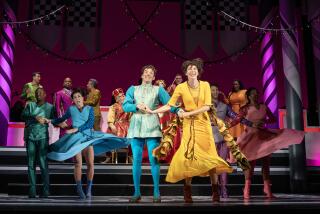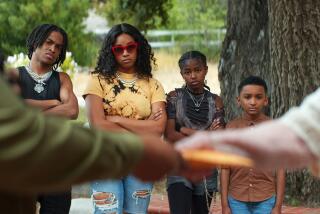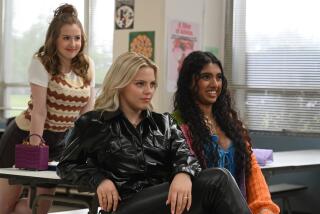Review: ‘Mary Poppins Returns,’ and she really shouldn’t have
“A thing of beauty is a joy forever.”
Keats said it first, but it was Mary Poppins, being practically perfect in every way, who found the right occasion for it, shortly after pulling an improbably large houseplant out of her carpetbag. She could have been speaking of the 1964 movie that bore her name. With its spoonfuls of sugar and chim-chim-cher-ee, its dancing cartoon penguins and marvelous Sherman Brothers songs, “Mary Poppins” remains one of the glories of the Disney canon, a wellspring of humor, emotion and audience goodwill that the studio has now seen fit to revisit 54 years later.
Anyone with a heart — or a basic grasp of the commercial logic of the movie industry — can understand at least the theoretical appeal of a movie called “Mary Poppins Returns.” As the proud father of a 2-year-old who already knows the lyrics to “Feed the Birds,” I’ll admit that I approached this belated sequel in a spirit of wary optimism. Our love for our precious childhood totems shouldn’t render those objects sacrosanct, and there’s no reason an iconic character can’t be revived, especially if the participants involved — Emily Blunt! Lin-Manuel Miranda! — strike the right balance of respect and imagination.
Certainly no one will accuse director Rob Marshall (“Chicago,” “Into the Woods”) or screenwriter David Magee (“Finding Neverland,” “Life of Pi”) of treating the Mary Poppins legacy with insufficient reverence. They might have made a more interesting film if they had. As it is, so much obvious care has been taken to reproduce and update the charms of the Robert Stevenson-directed original — to deliver an old-fashioned yet newfangled burst of family-friendly uplift — that “Mary Poppins Returns” winds up feeling both hyperactive and paralyzed. It sits there flailing on the screen, bright, gaudy and mirthless, tossing off strained bits of comic business and all but strangling itself with its own good cheer.
It fails through no lack of effort. Magee borrows instantly recognizable elements from the earlier film, but he also draws heavily on the superb P.L. Travers books that inspired it, particularly “Mary Poppins Comes Back” (1935) and “Mary Poppins Opens the Door” (1943). Real inspiration, however, proves elusive. The laborious Depression-era plot brings together a house in disarray, a looming bank foreclosure and a few scowling cardboard villains. The score, composed by Marc Shaiman, is as hardworking as it is monotonous; the new songs crowd together inside your head, coalescing into a thick, vaguely melodic vapor that evaporates immediately after the movie has ended.
The first of those tunes, “(Underneath the) Lovely London Sky,” is sung by a lamplighter named Jack (Miranda) as he rides his bicycle through the city’s cobblestone streets. The character is an obvious tip of the cap to Bert, the chimney sweep whom Dick Van Dyke brought to such rollicking life 54 years ago. Miranda, for his part, is there to help usher the audience’s Mary Poppins nostalgia into the 21st century, to sell us on the idea that this quaint vision of 1930s London might be worthy of its own hip, “Hamilton”-scaled phenomenon.
Perhaps so, though it will take more than a cheek-spraining smile and a vowel-butchering Cockney accent to pull it off. Jack isn’t the star of the show, of course. That would be Mary Poppins (Blunt), who once more floats down from the sky in a smart coat and flowered hat, holding her parrot-headed umbrella aloft. She touches down with nary a hair out of place, and with a fresh arsenal of sniffs, eye rolls and curt reprimands at the ready. Well, not entirely fresh: “Close your mouth, please, Michael, we are still not a codfish,” she snaps upon arriving back at 17 Cherry Tree Lane, where her now fully grown charges receive her in dumbfounded silence.
Michael (Ben Whishaw), of course, is Michael Banks, who now has three sweet, unruly young children of his own. (They’re played by Pixie Davies, Nathanael Saleh and Joel Dawson.) He and his sister, Jane (Emily Mortimer), a labor activist, are shocked to be reunited with the nanny who once took them on all manner of magical outings, as they only vaguely recall. You might well share their confusion, given that this Mary Poppins seems not to have aged a day, though she is also an inexplicably, undeniably different being. The effect might have been positively creepy if Blunt weren’t an innately appealing screen presence, though her charisma feels stifled here by the director’s timidity and the audience’s impossible expectations.
There are few acting challenges less enviable than going up against the Oscar-winning star turn that made Julie Andrews everyone’s favorite movie nanny. You could hardly fault any performer for feeling trapped in Andrews’ shadow, or for having a hard time getting a grip on Travers’ slippery, inscrutably lovely heroine: How do you play stern yet warm, mischievous yet authoritative, knowing yet sincere? I’m not sure, but not even Blunt’s pleasant singing and snappy rejoinders can make this stilted characterization spring fully to life — although Sandy Powell’s gorgeous costumes, from striped nursery garb to cute aquamarine swimwear, do more than their fair share.
For much of the early going, anyway, Mary Poppins slips quietly into the background, applying herself to the task of looking after Michael’s children. They lost their mother less than a year ago, and they might soon lose their house, thanks to an ill-advised loan from the bank where Michael now works. He is done no favors by his employer, William Weatherall Wilkins, who has a warm smile and a miser’s frigid heart, put across with sly if overly obvious villainy by Colin Firth.
Dead moms, stolen homes, cynical banks and earnest Bankses: That’s an awful lot of complications for even a wizardly problem solver like Mary Poppins to unravel. The original picture constructed its emotional throughline slowly, stringing together a series of delightful, episodic adventures that meandered their way toward a startlingly cathartic finale. The hectic, calculated busyness of “Mary Poppins Returns,” by contrast, wears you out almost immediately, in part because every throwaway gag and narrative digression has been so vainly contrived to pay off in a flurry of climactic would-be surprises.
It may be churlish to subject these two movies to point-by-point comparisons, but it also seems entirely appropriate. The big musical set-pieces here play like second-rate retreads: There’s a journey into an enchanted porcelain bowl that allows for some niftily integrated animation, and also a topsy-turvy visit with another one of Mary Poppins’ crazy relatives (a garishly upholstered Meryl Streep). The songs have an awful lot of child-friendly lessons to impart — appearances can be deceiving! Embrace the nuttiness of life! The dead never truly leave us! — and largely come off as muddled harangues.
The most successful callback is the inevitable Van Dyke cameo, probably the worst kept of the movie’s many secrets, and for good reason. The sight of the 92-year-old screen legend in glorious step-in-time form delivers that sensation you’ve been longing for: a fleeting but genuine rush of joy. It’s too little too late to make for a supercalifragilisticexpialidocious experience in retrospect, but for a moment, at least, you’re glad you stayed awake.
------------
‘Mary Poppins Returns’
Rating: PG, for some mild thematic elements and brief action
Running time: 2 hours, 11 minutes
Playing: Opens Dec. 19 in general release
-------------
ALSO
Justin Chang’s best movies of 2018: ‘Burning’ and ‘First Reformed’ lead a year of mystery
Kenneth Turan’s best movies of 2018: ‘Black Panther’ and ‘Leave No Trace’ top a banner year
[email protected] | Twitter: @JustinCChang
More to Read
Only good movies
Get the Indie Focus newsletter, Mark Olsen's weekly guide to the world of cinema.
You may occasionally receive promotional content from the Los Angeles Times.











